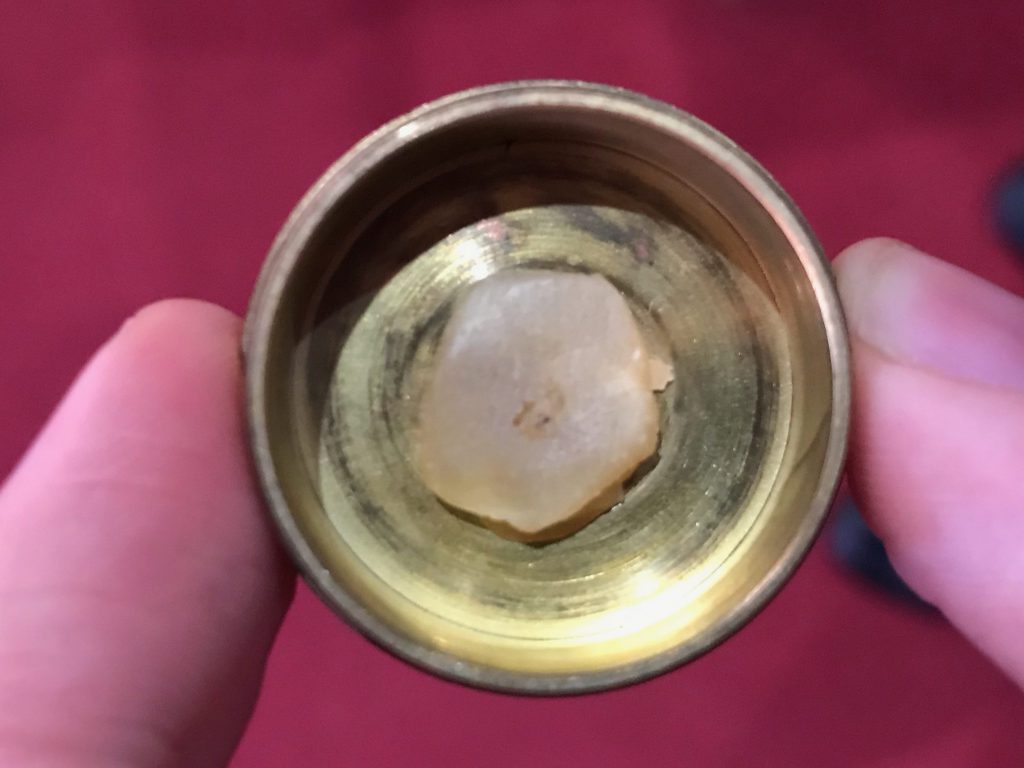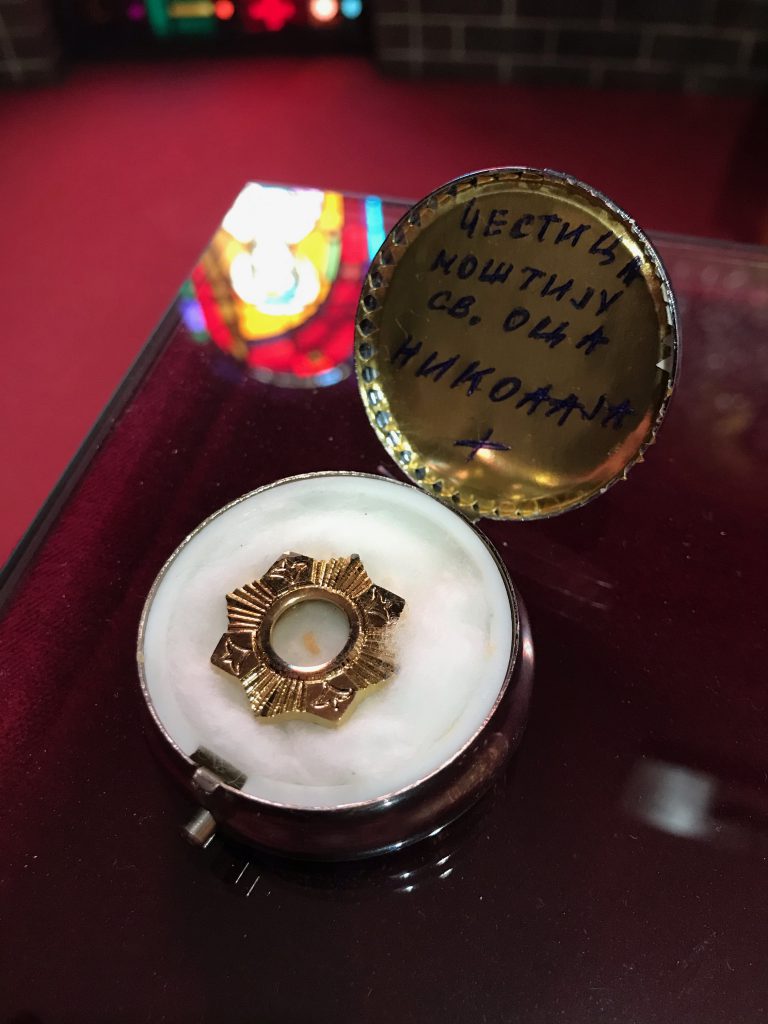Our St. Nicholas Church in Monroeville is blessed to have two very important relics. The first one is the relic of St. Nicholas the Wonderworker, the protector of our parish and the second one is the relic of St. Lazarus, a Serbian prince, who died in battle on Kosovo in 1389. Although it is clear these are two dear saints, particularly for the Serbian people, the question comes to mind: why do we have relics at all?
Orthodox teachings about relics
It is a well known fact that Orthodox Christians venerate relics. Many people in need undertake great efforts to travel to a monastery or to other Holy places where the relics of the Saints rest, so they may receive blessing, healing, and health restored. It is apparent to anyone who ever venerated a relic that these relics have power. More importantly, we must remember that this power does not from the relics themselves, but from God, who radiates His divine energies through their relics. Ultimately, our veneration of a Saint is veneration of our Lord, who glorifies the Saint whose relics we venerate.
God glorifies a certain individual and sanctifies him or her because of their way of life while they were alive. The goal of Christian life is to become as Christlike as possible. And to do that, the Saints of the Church put in a lot of effort to achieve that goal. They fasted, prayed, endured tortures with patience. Moreover, they did not think highly of themselves; they cut off judgmental thoughts and did other things the Church teaches us to do. By being persistent on their path, they attracted God’s Grace and mercy, which is given to those who seek it with their whole heart.
The gift of the Holy Spirit
As a good God, who loves mankind, God sends gifts to his Saints that are beyond comprehension and beyond their asking. The greatest gift that God can send to someone is the gift of the Holy Spirit. It is exactly this gift that was given to God’s Saints; and with it come other gifts because the Holy Spirit is the repository of all gifts.
When God sends the Holy Spirit to an individual, that Spirit permeates the whole body and soul of a Christian. Speaking in Christian terms, the person is being sanctified. This sanctification does not leave upon their death but is continued even after death. After the body is separated from the soul, the only thing that remains after somebody’s death which is visible and tangible to us is the body. In the case of sanctified individuals, that is Saints, this body still contains the Holy Spirit and His divine energies. By coming to venerate the relics of Saints, we thereby profess that someone whose relics we venerate is glorified by God. By venerating their relics, we are receiving sanctification and blessings which God passes down to us through a Saint we venerate.
This is why we are so blessed to have relics of St. Lazarus and St. Nicholas the Wonderworker. We believe that by having their relics in our Church, they are mystically sanctifying us and giving us their blessings which God has bestowed upon them by the Holy Spirit.
Let us live worthy of the presence of those saints who with their relics dwell among us!
The holy martyr Lazar [Lazarus], Prince of Serbia
Lazar was one of the Serbian noblemen who ruled the Serbian empire after the death of Tsar Dušan. After the death of Tsar Uroš, Patriarch Ephraim crowned Lazar as the Serbian king. Lazar sent a delegation to Constantinople with the monk Isaiah to implore the patriarch to remove the anathema from the Serbian people. He fought against the Turkish powers on several occasions. Finally, on June 15, 1389 A.D., he fought with the Turkish Emperor Amurat at Kosovo Polje [the Field of Blackbirds] where he was beheaded.

His body was translated to and interred in Ravanica, the monastery he founded [Zaduzbina] near Ćuprija, and was later translated to [New] Ravanica in Srem. From there, during the Second World War (1942), it was translated to Belgrade and placed in the Cathedral Church of the Holy Archangel Michael, where it rests today incorrupt, extending comfort and healing to all those who turn to him with prayer.(*) St. Lazar restored the monasteries of Hilandar [Mt. Athos] and Gornjak. He built Ravanica and Lazarica [in Kruševac] and was a benefactor of the Russian monastery St. Pantaleon [Mt. Athos] as well as many other churches and monasteries.
(*) In 1989, on the occasion of the 600th anniversary of his martyrdom, St. Lazar’s relics were again translated to the Monastery of Ravanica in Ćuprija. —Trans.**
Saint Nicholas the Wonderworker, Archbishop of Myra in Lycia
Saint Nicholas was the only son of Theophanes and Nona, wealthy citizens of the city of Patara in Lycia. Since he was their only son, his parents returned him to God by dedicating Nicholas’ life to the Lord. Nicholas learned the spiritual life from his uncle Nicholas, Bishop of Patara. He was tonsured a monk in the Monastery of New Zion founded by his uncle.
Following the death of his parents, Nicholas distributed all his inherited goods to the poor, not keeping anything for himself. As a priest, he was known for his charity, even though he carefully concealed his works, fulfilling the words of the Lord: Let not thy left hand know what thy right hand doeth (Matthew 6:3). Nicholas decided to give himself to solitude and silence until his death. But a voice from on high came to him and said: “Nicholas, for your ascetic labor, work among the people, if thou desirest to be crowned by Me”. Immediately after that, by God’s wondrous providence, he was ordained archbishop of the city of Myra.
Defender of God’s Truth
Merciful, wise and fearless, Nicholas was a true shepherd to his flock. During the persecution of Christians under Diocletian and Maximian, he was cast into prison. But even there he taught the people the Law of God. He was present at the First Ecumenical Council of Nicaea [325] and, out of great zeal for the truth, struck the heretic Arius with his hand. As a result, he was removed from the Council and from his archiepiscopal duties, until the Lord Christ Himself and the Most-holy Theotokos appeared to several of the chief hierarchs and revealed their approval of Nicholas. A defender of God’s truth, this wonderful saint was ever bold as a defender of justice among the people. On two occasions, he saved three men from an undeserved sentence of death.

Even during his lifetime, the people considered Nicholas a saint and invoked his aid in difficulties and in distress. He appeared both in dreams and in person to those who called upon him. And he helped them easily and speedily, whether close at hand or far away. A light shone from his face as it did from the face of Moses. By his presence alone, he brought comfort, peace and good will among men. In old age he became ill for a short time and entered into the rest of the Lord, after a life of labor and fruitful toil, to rejoice eternally in the Kingdom of Heaven, continuing to help the faithful on earth by his miracles and to glorify his God. He entered into rest on December 6, 343 A.D.
Other gems in our parish
There are other hidden gems in our parish and they can be found in our antemension. To find out what the antemension is, make sure to check our blog for the article on antemension which is coming soon.

5 Responses
Thank you! Such wonderful information for us all. And the pictures of the Holy Relics – extra special to see. Please keep the information coming. And because not everyone has the time to ‘browse’ this new website, perhaps Fr. Stefan would announce – from the Altar and in the weekly bulletin – where on the website our parishioners might find this great information. Thank you, again.
Wonderful information, Father! Our parish is truly blessed to have these relics.
Once again great infomation. We at St. Nicholas are Blessed -to have these in are church.
A wonderful explanation of our veneration of relics and two most deserving Saints in Ser nbi Ian Orthodox Christian history. Thank you so much for sharing.
Truly a blessing! Glory to God! 🙏☦️🙏